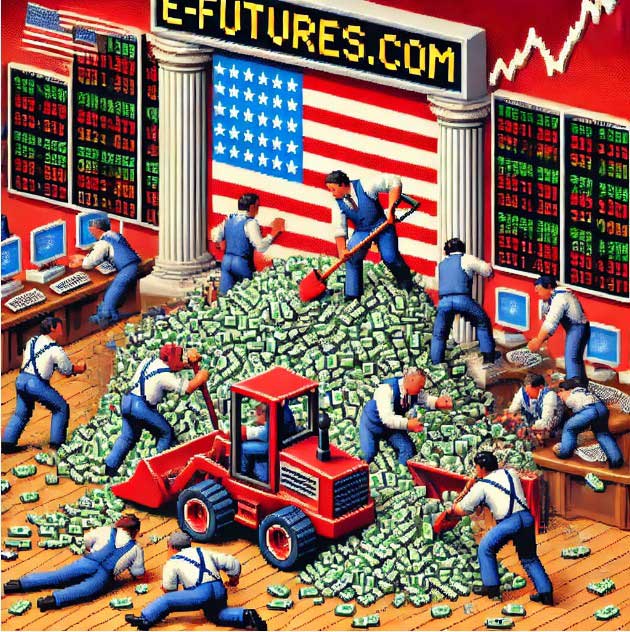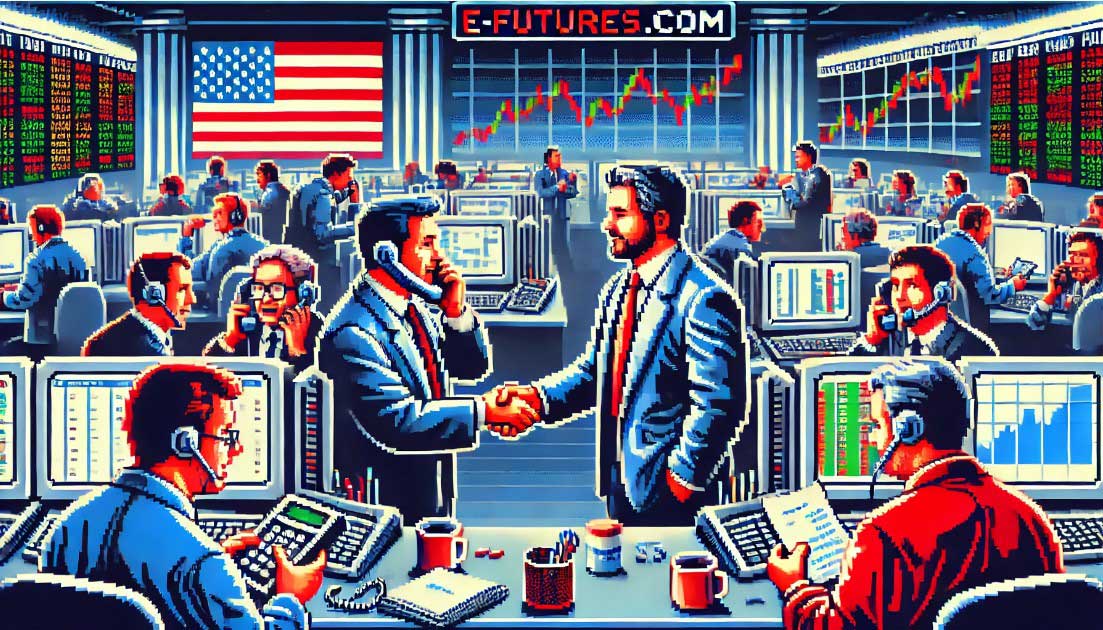The futures market holds a significant position in the financial landscape, functioning as a critical mechanism within the global economy. It provides an arena where future traders, ranging from individuals to corporations, can hedge against potential risks, speculate on price movements, and diversify portfolios. With the growth of futures trading in recent decades, this market has become a foundational pillar in the financial sector. Through instruments such as the e-mini futures, traders gain access to a world of opportunities for profit and risk management, enabling the futures market to evolve as a strategic tool that offers both short-term gains and long-term economic stability.
Understanding the Futures Market and Its Role in the Global Economy
The futures market serves as a global marketplace where standardized contracts are traded, committing parties to buy or sell specific assets at predetermined prices and dates. These assets can range from physical commodities, such as crude oil, gold, and wheat, to financial instruments like indices, interest rates, and currencies. Futures trading allows participants to protect against price fluctuations, or “hedge,” and to speculate on price movements. This duality is integral to futures in trading, as it serves both those looking for stability (hedgers) and those seeking profit opportunities (speculators).
In the context of the global economy, futures trading acts as a stabilizing force. Futures markets allow companies to lock in prices, reducing uncertainty, especially for firms in highly volatile sectors. For example, an airline company might use futures to secure fuel prices and ensure budget stability. By securing these prices, companies can better manage their cash flows and investments, indirectly impacting employment, wages, and even consumer prices. Furthermore, futures trading enables global economies to become more interconnected, as the prices set in futures markets influence decisions in major sectors across continents.
The Rise of Futures Trading in the Financial Sector
The popularity of futures trading in the financial sector stems from its origins in the 19th century, where it began with agricultural commodities. Farmers and buyers would agree on a set price for products like corn or wheat, which provided stability for both parties. This type of trading became increasingly formalized with the creation of exchanges like the Chicago Board of Trade (CBOT) in 1848, where standardized contracts were introduced. Futures trading quickly spread to other commodities, and by the 20th century, futures contracts for financial assets, like bonds and indices, began to take shape.
This shift from agricultural to financial futures transformed futures trading. The introduction of financial futures, such as the S&P 500 futures and later e-mini futures, brought a surge of interest from the financial sector. Financial futures allowed a broader array of investors, from individual traders to institutional firms, to manage risk and speculate. E-mini futures, in particular, made futures trading more accessible by offering smaller contracts with lower capital requirements. Their popularity has only increased as these futures in trading have proven lucrative, attracting both seasoned future traders and newcomers.
Hedging Futures: A Key Tool for Mitigating Risk
Hedging futures has become a widely used technique for managing risk in futures trading. A futures hedge involves taking a position in a futures contract to offset potential losses in an existing position or anticipated future transactions. This strategy is particularly valuable to companies dealing with volatile commodities or financial instruments. For example, a wheat farmer might use futures to lock in a sale price before harvesting, thus protecting against price declines. Similarly, companies that rely on imported materials may hedge against currency fluctuations by taking a futures position in the relevant foreign currency.
The use of futures hedging extends beyond corporations to investors and portfolio managers. These individuals often use futures contracts to hedge market risks, such as interest rate changes or stock market downturns, and stabilize returns. By hedging through futures, investors can maintain exposure to specific sectors while controlling for unforeseen price swings. The effectiveness of this strategy is apparent in market downturns, where a well-hedged position using futures can significantly mitigate losses. Given the volatility in global markets, futures in trading have become a go-to for risk management, providing peace of mind to businesses and individual investors alike.
The Role of Futures Brokers in Facilitating Futures Trading
For anyone looking to succeed in futures trading, the role of a futures broker is indispensable. Futures brokers act as intermediaries who connect traders with exchanges, enabling the buying and selling of futures contracts. They provide future traders with the necessary trading platforms, resources, and market insights to navigate the complexities of futures in trading. Additionally, a futures broker ensures that clients comply with exchange regulations and help manage the logistical aspects of trading, such as margin requirements and contract specifications.
Futures brokers offer more than just transactional services; they serve as advisors who help future traders develop trading strategies, often providing insights on market trends and analysis. For instance, an experienced broker might advise clients on diversifying their positions by trading e-mini futures, which offer liquidity and flexibility with smaller contract sizes. Brokers may also provide access to advanced trading tools, real-time data, and research reports to support their clients’ trading decisions. By collaborating closely with their clients, futures brokers facilitate informed, timely trades, allowing traders to achieve their financial goals more effectively.
The Importance of an Experienced, Reputable, and Compliant Futures Broker
The futures market is complex, requiring a thorough understanding of trading regulations, market dynamics, and risk management. Thus, having an experienced and reputable futures broker is critical for any future trader. An experienced broker brings invaluable knowledge of market intricacies, helping traders navigate volatile periods, such as economic recessions or geopolitical disruptions. Such brokers often have in-depth insights into different futures contracts, including popular options like e-mini futures, and can recommend strategies tailored to the client’s risk profile and investment horizon.
Reputation is equally important in futures trading, as brokers with a strong track record inspire trust and credibility. The reputation of a broker is a testament to their ethical practices, reliability, and commitment to clients’ success. This becomes particularly crucial in futures markets, where trust and transparency are key, given the high-stakes nature of leveraged trading. Traders need a broker who not only executes trades efficiently but also adheres to the best practices in the industry.
Compliance with regulatory bodies is also paramount in futures trading. In the United States, for instance, the Commodity Futures Trading Commission (CFTC) and the National Futures Association (NFA) set guidelines to protect investors and ensure market integrity. A compliant futures broker must adhere to stringent financial standards, record-keeping protocols, and risk management practices. Choosing a broker who follows these regulations reduces the risk of fraud and protects traders’ assets, especially in the highly leveraged environment of futures trading.
Why E mini Futures Are a Preferred Instrument in Futures Trading
E mini futures are one of the most popular products in futures trading, particularly appealing to individual traders and smaller investors. These contracts are essentially smaller versions of standard futures contracts, making them accessible to a broader audience due to their lower margin requirements. The e-mini futures market includes widely recognized contracts, such as the E-mini S&P 500, which tracks the S&P 500 index, and other indices covering technology, energy, and financial sectors.
E-mini futures have revolutionized futures trading by offering liquidity, flexibility, and affordability. They are traded almost 24/7, allowing future traders to react to global events and economic news instantly. This round-the-clock trading is invaluable for managing positions in dynamic markets where prices can shift significantly overnight. Additionally, e-mini futures provide a way to diversify portfolios with minimal capital compared to full-sized contracts, offering future traders a means to engage in futures trading without committing large amounts of capital upfront.
The futures market has become an essential component of the global economy, providing future traders, corporations, and investors with powerful tools for managing risks and seeking returns. Futures in trading have evolved from agricultural commodities to include a vast range of assets, with e-mini futures serving as a gateway for more accessible participation in this market. The popularity of futures trading in the financial sector is a testament to its ability to facilitate hedging and speculation in a regulated environment, making it a versatile option for risk mitigation and profit generation.
Futures brokers play a crucial role in enabling traders to navigate this complex market, offering essential guidance, insights, and tools to enhance trading strategies. The importance of a reputable, experienced, and compliant futures broker cannot be overstated, as it ensures that future traders operate within safe, regulated parameters while maximizing their potential returns. With global markets becoming increasingly interconnected and volatile, the demand for futures trading is expected to continue rising, solidifying its place in the world of finance. For any aspiring future trader, understanding the dynamics of futures trading, and leveraging the expertise of a qualified futures broker, are critical steps toward successful participation in this influential market.
To open an account with E-Futures.com, please click here.
Ready to start trading futures? Call US 1(800)454-9572 – Int’l (310)859-9572 email info@cannontrading.com and speak to one of our experienced, Series-3 licensed futures brokers and start your futures trading journey with E-Futures.com today.
Disclaimer – Trading Futures, Options on Futures, and retail off-exchange foreign currency transactions involves substantial risk of loss and is not suitable for all investors. Past performance is not indicative of future results. You should carefully consider whether trading is suitable for you in light of your circumstances, knowledge, and financial resources. You may lose all or more of your initial investment. Opinions, market data, and recommendations are subject to change at any time.
Important: Trading commodity futures and options involves a substantial risk of loss. The recommendations contained in this writing are of opinion only and do not guarantee any profits. This writing is for educational purposes. Past performances are not necessarily indicative of future results.
**This article has been generated with the help of AI Technology. It has been modified from the original draft for accuracy and compliance.
***@cannontrading on all socials.








